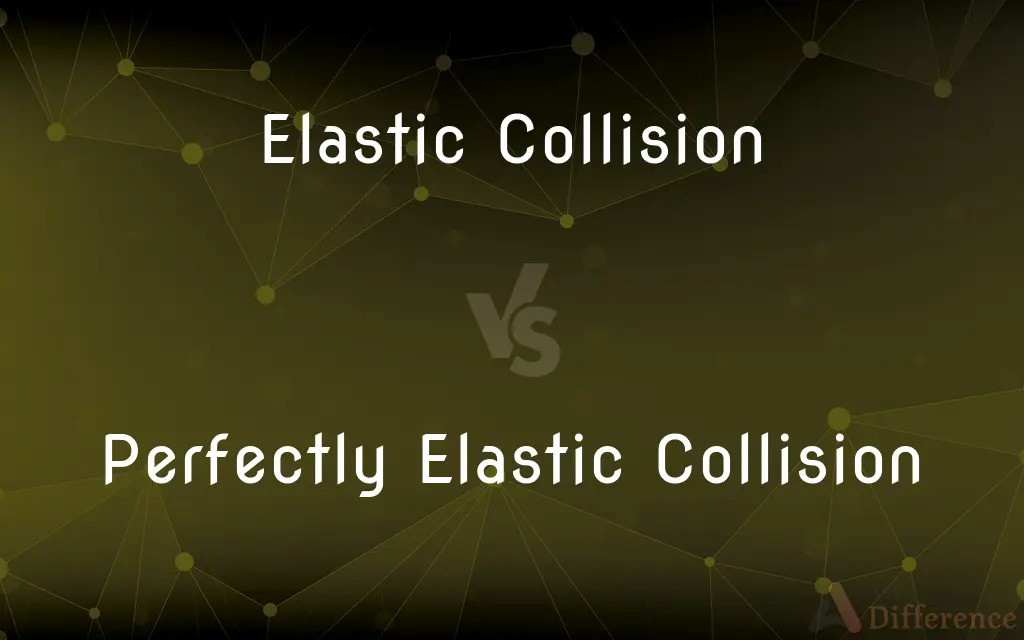Elastic Collision vs. Perfectly Elastic Collision — What's the Difference?
By Maham Liaqat & Fiza Rafique — Published on February 21, 2024
Elastic collisions and perfectly elastic collisions both conserve kinetic energy and momentum, but "perfectly elastic" emphasizes an ideal state with no energy loss to other forms, such as heat or sound, which is rare in real-world scenarios.

Difference Between Elastic Collision and Perfectly Elastic Collision
Table of Contents
ADVERTISEMENT
Key Differences
In physics, both elastic collisions and perfectly elastic collisions involve the conservation of total kinetic energy and total momentum before and after the collision. The term "elastic collision" is used to describe any collision where this conservation occurs, which can include real-world interactions where some minor energy transformations might still happen, such as into sound or slight deformations that are quickly recovered.
A "perfectly elastic collision," however, is a more theoretical concept used to describe a collision in which there is absolutely no energy conversion into other forms. In such collisions, the objects involved completely rebound without any loss of kinetic energy, which is an idealized scenario often not achievable in practical situations due to inevitable energy dissipation mechanisms like friction and air resistance.
In practical terms, elastic collisions are commonly observed in situations like billiard balls striking each other, where the kinetic energy and momentum are largely conserved, but some sound is produced, indicating a minor energy transformation. Perfectly elastic collisions are often used in physics problems and models to simplify calculations and understand fundamental principles, as they assume no energy is lost to heat, sound, or any form of energy outside of the kinetic energy of the objects involved.
Understanding the distinction between these two types of collisions is crucial in physics to comprehend how energy and momentum are conserved in different scenarios and to appreciate the simplifications made in theoretical models compared to the complexities of real-world phenomena.
Comparison Chart
Kinetic Energy Conservation
Yes, but may include minor conversions to other forms
Absolute, with no conversion to other energy forms
ADVERTISEMENT
Momentum Conservation
Yes, in all cases
Yes, in all cases
Energy Loss to Other Forms
Minimal (e.g., sound, heat)
None
Real-World Occurrence
Common in many physical interactions (e.g., billiard balls)
Theoretical, rarely observed in nature
Example Use
Practical applications and real-world scenarios
Idealized models and theoretical physics problems
Compare with Definitions
Elastic Collision
A collision conserving kinetic energy and momentum, with minor energy transformations.
A game of billiards demonstrates elastic collisions with slight sound production.
Perfectly Elastic Collision
An ideal collision with no kinetic energy lost to other forms.
Perfectly elastic collisions are a theoretical concept often used in physics simulations to simplify calculations.
Elastic Collision
Applies to systems with quick energy recovery.
Elastic collisions in pendulum assemblies demonstrate energy conservation and momentum transfer.
Perfectly Elastic Collision
Useful for understanding fundamental physics principles.
Perfectly elastic collisions in particle physics models help explain conservation laws in isolated systems.
Elastic Collision
Observed in everyday physical phenomena.
Elastic collisions are evident when playing sports like soccer or basketball, where the ball bounces off surfaces or other balls.
Perfectly Elastic Collision
Assumes no sound, heat, or deformation energy loss.
The concept of perfectly elastic collisions excludes any real scenario where friction or air resistance is present.
Elastic Collision
Practical for studying real-world physics.
In car safety tests, elastic collisions help understand how impacts affect vehicle motion and occupant safety.
Perfectly Elastic Collision
Rarely observed in nature due to inevitable energy losses.
In a vacuum with no air resistance, collisions approach perfectly elastic behavior but are still idealized.
Elastic Collision
Involves some energy dispersion to the environment.
When two rubber balls collide, the slight sound heard indicates a minor loss of kinetic energy.
Perfectly Elastic Collision
Serves as a baseline for theoretical exploration.
Perfectly elastic collisions provide a framework for exploring maximum energy and momentum conservation scenarios in physics.
Common Curiosities
Can perfectly elastic collisions occur in daily life?
Perfectly elastic collisions are an idealized concept and are not observed in everyday life due to unavoidable energy losses to sound, heat, or deformation.
Can molecular or atomic collisions be perfectly elastic?
At the microscopic level, such as in ideal gases, collisions can often be approximated as perfectly elastic, especially in theoretical models and under certain conditions.
How do computer simulations use perfectly elastic collisions?
Simulations often use perfectly elastic collisions to model ideal scenarios in physics, engineering, and game development, allowing for simplified calculations and analyses.
Why are perfectly elastic collisions important in physics?
They provide a simplified model to understand the conservation of kinetic energy and momentum, helping to establish fundamental principles without the complexity of real-world energy losses.
What role does material property play in the elasticity of a collision?
The elasticity of materials involved in a collision influences energy recovery and conservation. More elastic materials, like rubber, tend to have collisions closer to the elastic end of the spectrum.
How do elastic and perfectly elastic collisions apply to conservation laws?
Both types of collisions illustrate the conservation of momentum and kinetic energy, with perfectly elastic collisions adhering strictly to these conservation laws without any energy dissipation.
How can we differentiate between elastic and perfectly elastic collisions in experiments?
By measuring the kinetic energy before and after the collision. In perfectly elastic collisions, the kinetic energy remains constant; in elastic collisions, there's a slight decrease due to minor energy transformations.
Are all collisions in vacuum perfectly elastic?
Not necessarily. While a vacuum eliminates air resistance, other factors like surface imperfections and internal material deformations can prevent a collision from being perfectly elastic.
Can the concept of perfectly elastic collisions be applied to financial or economic models?
While primarily a physics concept, the idea of no loss in an exchange can metaphorically apply to certain economic models where transactions are assumed to have no frictional costs.
Can the efficiency of a collision be measured to determine its type?
Yes, by comparing the kinetic energy before and after the collision, one can gauge the efficiency and categorize the collision as elastic or perfectly elastic based on energy retention.
What practical applications rely on the principles of elastic collisions?
Many areas, including vehicle crash safety design, sports equipment manufacturing, and collision-based physical experiments, rely on understanding elastic collision principles.
Why are perfectly elastic collisions rare in mechanical systems?
Mechanical systems often involve energy loss due to factors like friction, air resistance, and material deformation, making perfectly elastic collisions practically unattainable.
How do elastic and perfectly elastic collisions differ in energy transfer?
In elastic collisions, energy is primarily transferred between the colliding objects with minimal loss, while in perfectly elastic collisions, the energy transfer is complete without any loss to the environment.
How do quantum or subatomic particles adhere to these collision concepts?
Subatomic particles, such as electrons in a vacuum, can exhibit behaviors close to perfectly elastic collisions due to minimal interaction with the environment, highlighting quantum mechanics' role in collision dynamics.
What educational purpose do perfectly elastic collisions serve?
They help students grasp the conservation laws in a simplified context before introducing the complexities of real-world phenomena where energy dissipation occurs.
Share Your Discovery

Previous Comparison
Deviation vs. Standard Deviation
Next Comparison
Pikelets vs. CrumpetsAuthor Spotlight
Written by
Maham LiaqatCo-written by
Fiza RafiqueFiza Rafique is a skilled content writer at AskDifference.com, where she meticulously refines and enhances written pieces. Drawing from her vast editorial expertise, Fiza ensures clarity, accuracy, and precision in every article. Passionate about language, she continually seeks to elevate the quality of content for readers worldwide.














































